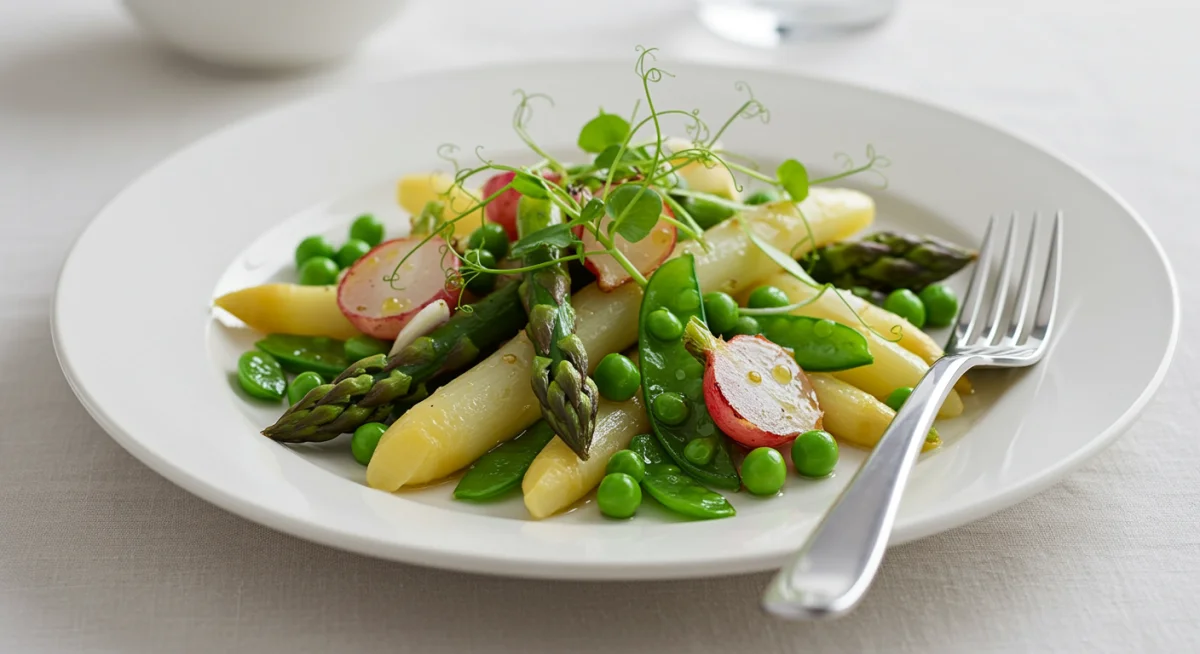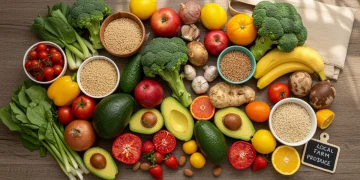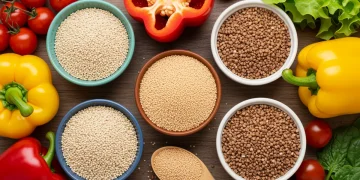Seasonal Eating 2025: Spring Recipes for Immunity & Savings

Seasonal eating in 2025 offers a powerful way to enhance immunity, champion local farms, and achieve significant cost savings, making it a smart and delicious choice for a healthier spring.
As we step into the vibrant spring of 2025, there’s a growing awareness about the profound benefits of aligning our diets with nature’s rhythm. Embracing seasonal eating in 2025 isn’t just a culinary trend; it’s a holistic approach to health, sustainability, and smart budgeting. This guide delves into six fresh spring recipes designed not only to delight your palate but also to boost your immunity, support local produce, and offer a tangible 10% cost saving.
The Power of Seasonal Eating: Why Spring 2025 Matters
Seasonal eating involves consuming fruits and vegetables at the peak of their harvest season. This practice brings a multitude of benefits, from enhanced flavor and nutritional value to significant economic and environmental advantages. In spring 2025, as the earth awakens, so too does a bounty of fresh, nutrient-dense produce.
When produce is picked at its prime, it hasn’t endured long transportation routes or artificial ripening processes. This means it retains more of its inherent vitamins, minerals, and antioxidants, which are crucial for maintaining robust health. Furthermore, the act of choosing seasonal foods often leads to supporting local farmers, reducing your carbon footprint, and fostering a stronger community food system.
Nutritional Superiority and Flavor Intensity
Foods harvested in season are often more nutrient-dense than their out-of-season counterparts. The optimal growing conditions allow them to develop their full spectrum of vitamins, minerals, and phytonutrients. This translates directly to better health outcomes, including stronger immune function and improved overall well-being. The difference in taste is also undeniable; a ripe, in-season strawberry bursts with flavor in a way that an artificially ripened one simply cannot match.
- Enhanced Nutrient Content: Peak ripeness means maximum vitamins and minerals.
- Superior Flavor Profile: Tastes better due to natural maturation.
- Reduced Chemical Exposure: Often requires fewer preservatives or artificial ripening agents.
Economic and Environmental Advantages
Buying seasonal produce often means buying local, which cuts down on transportation costs and environmental impact. When food travels shorter distances, less fuel is consumed, leading to a smaller carbon footprint. This direct-from-farm approach also typically results in lower prices for consumers because there are fewer intermediaries in the supply chain. This is where the 10% cost saving comes into play; by eliminating these extra steps, you get fresher food at a better price.
Supporting local agriculture strengthens regional economies. It helps sustain family farms and keeps money circulating within the community. This interconnectedness creates a more resilient and sustainable food system for everyone, ensuring that fresh, healthy food remains accessible.
The decision to embrace seasonal eating in spring 2025 is a conscious choice that positively impacts personal health, community well-being, and environmental sustainability. It is a simple yet profound way to reconnect with our food sources and enjoy the freshest ingredients nature has to offer.
Immunity-Boosting Spring Ingredients for 2025
Spring is a time of renewal, and our bodies often benefit from a dietary refresh. The seasonal produce available in spring 2025 is particularly rich in compounds known to bolster the immune system. Incorporating these ingredients into your daily meals can help ward off seasonal sniffles and keep you feeling energetic.
From leafy greens to vibrant berries, spring offers a diverse palette of ingredients that are powerhouses of vitamins, antioxidants, and anti-inflammatory compounds. Understanding which ones to prioritize can make a significant difference in your immune health.
Asparagus: A Fiber-Rich Detoxifier
Asparagus is one of spring’s earliest delights, packed with vitamins K, A, C, and folate. Its high fiber content aids digestion, and it contains powerful antioxidants that help protect cells from damage. Asparagus also boasts prebiotics, which feed beneficial gut bacteria, crucial for a healthy immune system.
- Rich in Folate: Essential for cell growth and immune function.
- Source of Vitamin K: Important for bone health and blood clotting.
- Contains Antioxidants: Fights free radicals and reduces inflammation.
Spinach and Other Leafy Greens: Nutrient Powerhouses
Spinach, kale, and collard greens are abundant in spring and are nutritional goldmines. They are excellent sources of vitamins A, C, and K, as well as iron and calcium. Vitamin C is a well-known immune booster, while vitamin A plays a critical role in maintaining healthy mucous membranes, which are a first line of defense against pathogens.
These greens also contain chlorophyll and various phytonutrients that offer anti-inflammatory and antioxidant benefits. Regular consumption of leafy greens can contribute to a stronger immune response and overall vitality.
Strawberries: Vitamin C Champions
As spring progresses, strawberries emerge, bringing with them a burst of sweetness and a hefty dose of vitamin C. Just a handful of strawberries can provide more than your daily recommended intake of this essential vitamin, which is vital for immune cell function and collagen production. They also contain anthocyanins, powerful antioxidants that give them their vibrant red color and provide additional health benefits.
By consciously choosing these immunity-boosting spring ingredients, you are not only enjoying delicious food but also proactively supporting your body’s natural defenses as part of your seasonal eating in 2025 strategy.
Recipe 1: Spring Asparagus and Lemon Risotto (Cost Saving: 10%)
This creamy, bright risotto celebrates the delicate flavor of fresh spring asparagus, elevated by zesty lemon. It’s a comforting yet light dish that makes an ideal main course or a sophisticated side. The use of in-season asparagus helps keep costs down, contributing to your 10% saving goal.
Risotto might seem intimidating, but with a little patience, it’s a rewarding experience. The key is to gradually add warm broth, stirring frequently to achieve that perfect creamy consistency. This recipe is designed to be approachable for home cooks while delivering restaurant-quality taste.
Ingredients and Preparation
For this recipe, you’ll need fresh asparagus, Arborio rice, vegetable broth, a shallot, garlic, white wine, lemon zest and juice, Parmesan cheese, and a touch of butter or olive oil. The freshness of the asparagus is paramount here, so select firm, bright green spears.
Begin by sautéing the finely chopped shallot and garlic until translucent. Add the Arborio rice and toast it lightly before deglazing with white wine. Then, gradually add the warm vegetable broth, one ladle at a time, stirring continuously until each addition is absorbed. In the last few minutes, stir in the blanched asparagus pieces, lemon zest, and juice. Finish with Parmesan and a knob of butter for extra richness.
- Prep Time: 15 minutes
- Cook Time: 25 minutes
- Servings: 4
Tips for Maximizing Flavor and Savings
To ensure maximum flavor, use homemade vegetable broth if possible, or a high-quality store-bought one. For cost savings, buy asparagus when it’s on sale during its peak season. You can also substitute Parmesan with a less expensive hard cheese if needed, though the flavor profile will differ slightly. A squeeze of fresh lemon juice at the end brightens the entire dish.
This Spring Asparagus and Lemon Risotto is a testament to how simple, seasonal ingredients can combine to create a truly memorable meal, fitting perfectly into the philosophy of seasonal eating in 2025.
Recipe 2: Spinach and Feta Stuffed Chicken Breasts with Roasted Radishes
This recipe offers a delicious and healthy way to incorporate two spring powerhouses: spinach and radishes. Lean chicken breasts are stuffed with a savory mixture of fresh spinach, creamy feta, and aromatic herbs, then pan-seared and baked. Roasted radishes, often overlooked, transform into sweet, mellow gems when cooked, making a perfect accompaniment.
This dish is surprisingly easy to prepare but looks elegant enough for a special occasion. It’s also packed with protein and nutrients, making it an excellent choice for boosting immunity and maintaining energy levels.

Crafting the Flavorful Filling
The filling for the chicken breasts is a simple yet potent blend. Sauté fresh spinach until wilted, then squeeze out any excess moisture. Combine it with crumbled feta cheese, minced garlic, a pinch of nutmeg, and a sprinkle of dried dill or fresh chives. Season with salt and pepper. This mixture provides a wonderful contrast to the lean chicken and adds an immune-boosting punch.
Carefully slice a pocket into each chicken breast, being careful not to cut all the way through. Spoon the spinach and feta mixture into these pockets. You can secure the opening with toothpicks if necessary, though often the mixture holds well during cooking.
Roasting Radishes to Perfection
Many people only experience radishes raw, but roasting them unlocks a whole new dimension of flavor. When roasted, their peppery bite mellows into a sweet, slightly earthy taste. Toss whole radishes (tops trimmed) with olive oil, salt, and pepper. Roast them alongside the chicken or separately until tender and slightly caramelized.
- Flavor Transformation: Roasting mellows radish’s sharpness.
- Nutrient Retention: Cooked radishes retain vitamins and minerals.
- Versatile Side: Pairs well with various proteins.
This dish exemplifies how seasonal eating in 2025 can be both delicious and incredibly beneficial for your health, offering a balanced meal that supports your immune system and celebrates spring’s bounty.
Recipe 3: Fresh Strawberry and Spinach Salad with Poppy Seed Dressing
Nothing screams spring quite like the combination of sweet strawberries and tender spinach. This vibrant salad is a refreshing and nutritious option, perfect for a light lunch or a bright side dish. The homemade poppy seed dressing adds a touch of sweetness and tang, tying all the flavors together beautifully.
This salad is not only delicious but also a powerhouse of vitamins, especially vitamin C from the strawberries and vitamins A and K from the spinach, all crucial for immune support. It’s a prime example of how simple, fresh ingredients can create a truly impactful meal, aligning perfectly with the principles of seasonal eating in 2025.
Assembling the Perfect Spring Salad
Start with a generous bed of fresh baby spinach. Add sliced ripe strawberries, which provide a burst of natural sweetness and antioxidants. To add texture and a savory element, consider adding a sprinkle of toasted pecans or walnuts, and perhaps some crumbled goat cheese or feta for creaminess. Red onion, thinly sliced, can add a subtle bite that complements the sweetness of the strawberries.
The beauty of this salad lies in its simplicity and the quality of its fresh ingredients. Opt for the freshest strawberries and spinach you can find, ideally from a local farmer’s market, to maximize flavor and nutritional benefits.
Homemade Poppy Seed Dressing
A homemade dressing elevates this salad from good to extraordinary. Whisk together apple cider vinegar, a touch of honey or maple syrup, Dijon mustard, a splash of olive oil, and poppy seeds. A little salt and pepper to taste will balance the flavors. This dressing is light, tangy, and perfectly complements the sweetness of the strawberries and the earthiness of the spinach.
- Dressing Base: Apple cider vinegar and olive oil.
- Sweetener Options: Honey or maple syrup for natural sweetness.
- Flavor Enhancers: Dijon mustard, poppy seeds, salt, and pepper.
This Fresh Strawberry and Spinach Salad is a delightful way to enjoy the best of spring produce. It’s quick to assemble, incredibly healthy, and a vibrant addition to any meal, embodying the spirit of fresh, immune-boosting seasonal eating in 2025.
Recipe 4: Spring Vegetable Frittata with Fresh Herbs
A frittata is a versatile and forgiving dish, perfect for using up whatever spring vegetables you have on hand. This recipe focuses on a medley of seasonal delights like spring onions, peas, and fresh dill, all bound together with eggs and a touch of cheese. It’s an ideal option for a healthy breakfast, brunch, or light dinner, and it’s incredibly budget-friendly, helping you save money while eating well.
The beauty of a frittata lies in its adaptability. You can easily swap out vegetables based on what’s freshest and most affordable at your local market, making it a cornerstone of smart seasonal eating in 2025.
Choosing Your Spring Vegetables
For this frittata, consider using thinly sliced spring onions, tender green peas (fresh or frozen, though fresh are superior in season), and finely chopped asparagus. Other excellent additions include chopped bell peppers, baby spinach, or even thinly sliced radishes. The key is to pre-cook any harder vegetables slightly to ensure they are tender in the final dish.
Sauté your chosen vegetables in a little olive oil until they are crisp-tender. This step ensures that the flavors are developed and the vegetables are cooked through when the eggs are added.
The Egg Base and Baking Process
Whisk together a dozen eggs with a splash of milk or cream, salt, and freshly ground black pepper. Incorporate a handful of grated cheese, such as Gruyère, cheddar, or a blend of Italian cheeses, for added flavor and richness. Once the vegetables are ready, spread them evenly in an oven-safe skillet.
Pour the egg mixture over the vegetables and cook on the stovetop over medium heat for a few minutes until the edges begin to set. Then, transfer the skillet to a preheated oven to finish baking until the frittata is puffed and golden brown. Garnish with fresh dill or parsley before serving.
- Versatile: Adaptable with various spring vegetables.
- Budget-Friendly: Uses affordable eggs and seasonal produce.
- Meal Flexibility: Great for breakfast, lunch, or dinner.
This Spring Vegetable Frittata is a delicious and economical way to enjoy the bounty of spring, providing essential nutrients and supporting your immune system through smart seasonal eating in 2025.
Recipe 5: Quick Pickled Radishes and Carrots
While not a full meal, quick-pickled radishes and carrots are an excellent way to add a tangy, crunchy element to almost any spring dish. They are incredibly easy to make, require minimal ingredients, and can elevate salads, sandwiches, or even grilled meats. This method also extends the shelf life of these seasonal vegetables, making the most of your local produce purchases and contributing to food waste reduction.
The vibrant colors and refreshing tang of these pickled vegetables make them a delightful addition to your spring table, highlighting the versatility of seasonal eating in 2025.

The Simple Pickling Process
To make quick pickles, you’ll need thinly sliced radishes and carrots. A mandoline slicer can help achieve uniform, thin slices, but a sharp knife works just as well. Pack the sliced vegetables tightly into a clean glass jar.
Prepare the pickling brine by heating equal parts water and white vinegar (such as distilled white vinegar or apple cider vinegar) with a pinch of salt and a spoonful of sugar until the salt and sugar dissolve. You can also add aromatics like black peppercorns, mustard seeds, or a bay leaf for extra flavor. Pour the hot brine over the vegetables, ensuring they are fully submerged. Let cool to room temperature, then seal and refrigerate.
Serving Suggestions and Benefits
These quick pickles are ready to eat in just a few hours, though they taste even better after a day or two in the refrigerator. They add a refreshing crunch and bright acidity to a variety of dishes. Try them on tacos, alongside roasted chicken, or as a vibrant topping for avocado toast. The pickling process also introduces beneficial probiotics, which are good for gut health and, by extension, immune function.
- Enhances Flavor: Adds a tangy, refreshing kick to meals.
- Extends Shelf Life: Reduces food waste by preserving vegetables.
- Gut Health Benefits: Introduces probiotics for a healthy microbiome.
Quick Pickled Radishes and Carrots are a testament to creative cooking with seasonal ingredients. They’re a simple yet impactful way to enjoy spring’s bounty and support your health through delicious seasonal eating in 2025.
Recipe 6: Lemon and Herb Roasted Chicken with Spring Root Vegetables
This recipe offers a hearty yet fresh meal that perfectly balances the robust flavors of roasted chicken with the delicate sweetness of spring root vegetables. Think baby carrots, small potatoes, and parsnips, all roasted together with fragrant lemon and herbs like rosemary and thyme. This one-pan wonder is not only easy to clean up but also ensures that all the delicious juices and flavors meld beautifully.
By utilizing seasonal root vegetables, you’re maximizing flavor and nutritional value while also adhering to budget-friendly principles, making this an ideal dish for your seasonal eating in 2025 repertoire.
Preparing the Chicken and Vegetables
Choose a whole chicken or bone-in, skin-on chicken pieces for maximum flavor and juiciness. Pat the chicken dry and rub it generously with a mixture of olive oil, lemon zest, minced garlic, fresh rosemary, and thyme. Season liberally with salt and black pepper, both inside the cavity (if using a whole chicken) and over the skin.
For the vegetables, opt for small, tender spring root vegetables. Baby carrots, new potatoes (halved or quartered), and parsnips are excellent choices. Toss them with olive oil, a squeeze of lemon juice, and a sprinkle of the same herbs used for the chicken. The goal is to create a harmonious flavor profile across all components of the dish.
Roasting for Perfection
Arrange the seasoned chicken and vegetables in a single layer on a large roasting pan. Ensure there’s enough space for air to circulate, which promotes even cooking and crispy skin on the chicken. Roast in a preheated oven until the chicken is golden brown and cooked through, and the vegetables are tender and slightly caramelized. Basting the chicken periodically with its pan juices will keep it moist and flavorful.
- One-Pan Convenience: Easy preparation and minimal cleanup.
- Flavor Infusion: Lemon and herbs permeate chicken and vegetables.
- Nutrient-Rich: Combines protein with essential vitamins from roots.
This Lemon and Herb Roasted Chicken with Spring Root Vegetables is a comforting and nutritious meal, perfect for showcasing the best of spring’s harvest. It’s a delicious way to support local produce, boost your immunity, and enjoy cost-effective seasonal eating in 2025.
| Key Aspect | Brief Description |
|---|---|
| Immunity Boost | Seasonal spring produce is rich in vitamins (C, A, K) and antioxidants crucial for immune system strength. |
| Local Produce Support | Choosing seasonal means supporting local farms, reducing food miles, and strengthening community food systems. |
| Cost Savings | Buying in-season and local can lead to approximately 10% savings due to reduced transportation and fewer intermediaries. |
| Recipe Focus | Six fresh spring recipes highlight key seasonal ingredients for delicious, healthy, and economical meals. |
Frequently Asked Questions About Seasonal Eating
The primary benefits include enhanced nutritional value, superior flavor, reduced environmental impact from shorter transportation distances, and significant cost savings due to peak availability and local sourcing. It also supports local economies and promotes a diverse diet.
Seasonal foods are typically harvested at their peak ripeness, meaning they contain higher concentrations of vitamins, minerals, and antioxidants essential for a strong immune system. Freshness ensures nutrient integrity, which directly translates to better cellular protection and immune response.
Yes, by purchasing produce when it’s in season and locally available, you often bypass high transportation costs and intermediary markups. This direct sourcing from farms or markets during peak abundance typically results in lower prices, easily achieving or exceeding a 10% saving.
In spring 2025, prioritize ingredients like asparagus, spinach, radishes, strawberries, spring onions, peas, and new potatoes. These items are at their peak freshness and offer a wealth of flavors and nutrients for diverse culinary applications.
Farmer’s markets are ideal for finding the freshest seasonal and local produce. Local co-ops, community-supported agriculture (CSA) programs, and even dedicated sections in grocery stores increasingly offer seasonal selections. Direct farm stands are also excellent options.
Conclusion
Embracing seasonal eating in 2025 is far more than just a dietary choice; it’s a lifestyle that nourishes your body, supports your community, and respects the environment. The six spring recipes shared here are just a starting point, demonstrating how readily available, fresh ingredients can be transformed into delicious, immunity-boosting meals while simultaneously offering tangible cost savings. By making a conscious effort to incorporate seasonal produce into your diet, you’re not only savoring the best flavors nature has to offer but also making a powerful investment in your health and the sustainability of our food systems. Let this spring be a season of vibrant health and culinary discovery.





